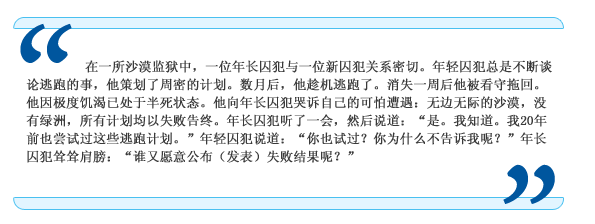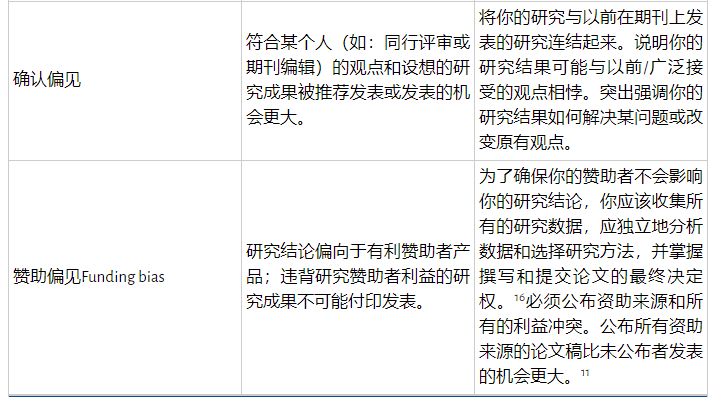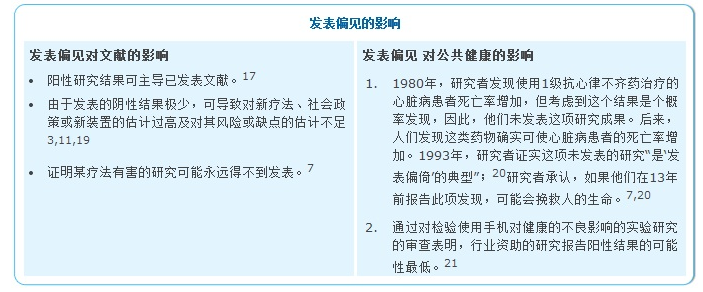博文
出版和报告偏见如何影响论文发表
|||

这则趣事恰如其分的诠释了危害科技文献的一个问题 – 发表偏见或报告偏见。1
发表偏见是指科技报告中的一种现象,即“阳性”结果(即具有显著意义的发现)的研究比“阴性”(即支持无效假定或不支持结果)的研究被发表的机会更大。2发表偏见的结果是,即使是被重要的阴性结果(如:证明某项新疗法无效的研究)也可能永远无法为科技界所了解。3
这种倾向发表阳性结果的偏见只是众多发表偏见类型的一种。由于这些偏见影响文章是否被接收发表,因此了解以下方面的内容非常重要
导致这些偏见的原因是什么
各类偏见及其解决方法
为什么要反对发表和报告偏见
偏见原因
导致报告和发表偏见的因素很多,主要原因有:
许多研究未能发表,其原因是研究者未提交需发表的论文。他们认为自己不能报告阳性或有意义的结果,期刊将会拒绝这样的论文。这种与投稿相关的偏见称为抽屉问题。4
期刊可能更偏向于阳性结果,因为阴性结果被引用的机会相对较低,从而会降低期刊的影响因子。
研究赞助者或资助单位可能偏向于符合自己利益的结果;据发现,赞助者可能会阻止不利结果的发表,行业资助的研究产生阳性结果的机会要远远超过由独立机构资助或从事的研究。5,6
各种偏见及其解决方法
科技文献中存在的各种发表和报告偏见如下表所示。1,7-11下表还提供了一些解决各类偏见的建议。在给期刊编辑的投稿信中,在陈述研究重要性时,应尽可能直接解决这些偏见。




为什么应该坚决反对偏见
发表与报告偏见与研究的目的背道而驰。这些偏见通过突出阳性结果的发表,已形成了“一个系统化非代表性”文献主体17并“导致科学诚信受到危害”。18
这将导致不良后果,例如:无效或危险的疗法、延长患者的痛苦及浪费资源(参见文本框:“发表偏见的影响”)。
反对“发表与报告偏见”将有助于维护科技文献的科学性。具体做法包括:提交未产生预期结果但所用方法完善的研究;提倡既要发表阴性结果也要发表阳性结果;客观无偏见地进行同行评审;拒绝资助机构影响研究方法、结果报告或发表决定。
通过共同努力,我们将会保证发表的研究成果在所有已完成的研究中更具代表性,并有助于维护科技文献的科学性。

春日研学润色好 —— editage意得辑润色全场9折,限时七天
活动时间:2020.3.24日-3.31日
【科学深度编辑】3位资深同行审稿人,从语言、内容、期刊投稿指导三方面,助您发表高IF期刊。
【优质润色】0.7元/词,修改语言语法+结构逻辑性,365天无限次免费大小修。
【标准润色】0.45元/词,一次性修改语言语法。
参考文献
Sterne JAC, Egger M, Moher D. (Editors) (2008). Chapter 10: Addressing reporting biases in Cochrane Handbook for Systematic Reviews of Interventions (eds. JPT Higgins and S Green). Version 5.0.1 [updated September 2008]. The Cochrane Collaboration.
Dickersin K (1990). The existence of publication bias and risk factors for its occurrence. Journal of the American Medical Association, 263: 1385–1389.
McGauran N, et al. (2010). Reporting bias in medical research—a narrative review. Trials, 11: 37.
Rosenthal R (1979). The "file drawer problem" and tolerance for null results. Psychological Bulletin, 86(3): 638–641. doi: 10.1037/0033-2909.86.3.638.
Bodenheimer T (2000). Uneasy alliance—clinical investigators and the pharmaceutical industry. New England Journal of Medicine, 342: 1539–1544.
Bekelman JE, Li Y, Gross CP (2003). Scope and impact of financial conflicts of interest in biomedical research. Journal of the American Medical Association, 289(4): 454–465.
Song F, Parekh S, Hooper L, Loke YK, Ryder J, Sutton AJ, et al (2010). Dissemination and publication of research findings: An updated review of related biases. Health Technology Assessment, 14(8): iii,ix–xi.
Mahoney MJ (1977). Publication prejudices: An experimental study of confirmatory bias in the peer review system. Cognitive Therapy and Research, 1(2): 161–175. doi: 10.1007/BF01173636.
Chopra SS (2003). Industry funding of clinical trials: Benefit or bias? Journal of the American Medical Association, 290(1): 113–114.
Lesser LI, Ebbeling CB, Goozner M, Wypij D, Ludwig DS (2007). Relationship between funding source and conclusion among nutrition-related scientific articles. PLoS Medicine, 4(1): e5.
Lee KP, Boyd EA, Holroyd-Leduc JM, Bacchetti P, Bero LA (2006). Predictors of publication: Characteristics of submitted manuscripts associated with acceptance at major biomedical journals. Medical Journal of Australia, 184: 621–626.
Sridharan L & Greenland P (2009). Editorial policies and publication bias: The importance of negative studies (editorial commentary). Archives of Internal Medicine, 169: 1022–1023.
Kotze JD, Johnson CA, O’Hara RB, Vepsäläinen K, Fowler MS (2004). Editorial. Journal of Negative Results—Ecology & Evolutionary Biology, 1: 1–5.
Koricheva J (2003). Non-significant results in ecology: A burden or a blessing in disguise? Oikos, 102: 397–401.
Leimu R & Koricheva J (2004). Cumulative meta-analysis: A new tool for detection of temporal trends and publication bias in ecology. Proceedings of the Royal Society of London, B271: 1961–1966.
International Committee of Medical Journal Editors. Uniform requirements for manuscripts submitted to biomedical journals: Writing and editing for biomedical publication [Accessed: June 14, 2011] Available from: http://www.ICMJE.org.
Rothstein HR, Sutton AJ, Borenstein M. (Editors) (2005). Chapter 1: Publication Bias in Meta-Analysis in Publication Bias in Meta-Analysis: Prevention, Assessment and Adjustments (eds. HR Rothstein, AJ Sutton, and M Borenstein). John Wiley & Sons Ltd.: Chichester, UK.
Editorial. The whole truth. New Scientist. May 1, 2004. Magazine issue 2445.
Scholey JM & Harrison JE (2003). Publication bias: Raising awareness of a potential problem in dental research. British Dental Journal, 194: 235–237.
Editorial: Dealing with biased reporting of the available evidence. The James Lind Library. [Accessed: June 14, 2011] Available from: www.jameslindlibrary.org.
Huss A, Egger M, Hug K, Huwiler-Müntener K, Röösli M (2007). Source of funding and results of studies of health effects of mobile phone use: Systematic review of experimental studies. Environmental Health Perspectives, 115: 1–4.
https://blog.sciencenet.cn/blog-769813-1225958.html
上一篇:工程学科学术论文撰写的四个注意事项
下一篇:小心,掠夺性期刊也可能有“真实的”同行评审